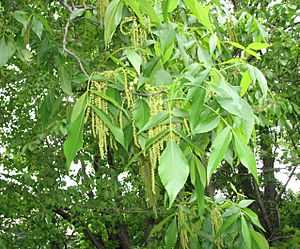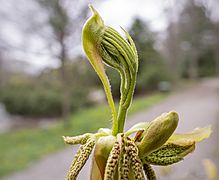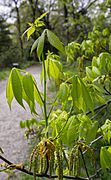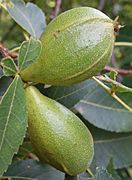Pignut hickory facts for kids
Quick facts for kids Pignut hickory |
|
|---|---|
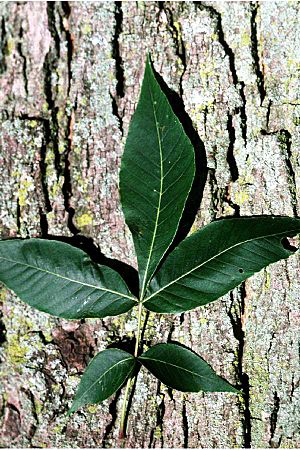 |
|
| Conservation status | |
| Scientific classification | |
| Genus: |
Carya
|
| Species: |
glabra
|
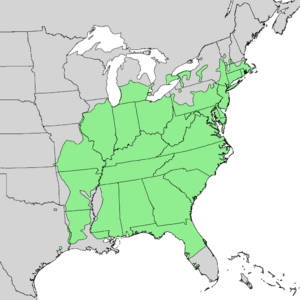 |
|
| Natural range of Carya glabra | |
The pignut hickory (scientific name: Carya glabra) is a common type of hickory tree. It grows in the oak-hickory forests of the Eastern United States and Canada. People also call it pignut, sweet pignut, coast pignut hickory, smoothbark hickory, swamp hickory, or broom hickory.
Its nuts are shaped like pears and ripen in September and October. They have a sweet, maple-like smell. Many wild animals love to eat these nuts. The tree's wood is very useful for many things, including heating homes. In the fall, its leaves turn a beautiful yellow color.
Contents
Habitat
Where Pignut Hickory Grows Naturally
The pignut hickory tree grows across most of the eastern United States. You can find it from central Florida all the way north to southern Massachusetts. It also grows north from the Gulf Coast through Alabama and Mississippi, up to Missouri, southeastern Iowa, and the Lower Peninsula of Michigan.
This tree grows best in the area around the lower Ohio River. It's very common in the Appalachian Mountains. A lot of the hickory wood harvested in Kentucky, West Virginia, the Cumberland Mountains of Tennessee, and the hills of the Ohio Valley comes from pignut hickory trees.
You can also find pignut hickory in southern Ontario, Canada. However, its range there is smaller. It's mostly found in the Niagara Peninsula, southern Halton Region, the Hamilton area near Lake Ontario, and along the northern shore of Lake Erie.
Climate Conditions for Pignut Hickory
Pignut hickory thrives in a humid climate. It usually gets between 760 to 2,030 mm (30 to 80 in) of rain each year. About 510 to 1,020 mm (20 to 40 in) of this rain falls during the growing season.
The amount of snowfall varies a lot. In the South, there's little to no snow. But in the mountains of West Virginia, southeastern New York, and southern North Carolina, it can get 2,540 mm (100 in) or more.
Temperatures where pignut hickory grows range from 7 °C (45 °F) in the north to 21 °C (70 °F) in Florida. In January, the average temperature is between -4° and 16 °C (25° and 60 °F). In July, it's between 21° and 27 °C (70° and 80 °F). The tree can survive extreme temperatures, from 46° to -30 °C (115° to -22 °F). The growing season lasts from 140 to 300 days, depending on the location.
Soils and Land Where Pignut Hickory Grows
Pignut hickory often grows on dry hilltops and slopes. But it also does well in moist places, especially in mountains and the Piedmont region. In the Great Smoky Mountains, it has been seen on dry, sandy soils at lower elevations. It can grow at high elevations, up to 1480 m (4,850 ft).
For example, on Beanfield Mountain in southwest Virginia, pignut hickory is a main tree on sunny, steep upper slopes. It grows with northern red oak and white oak. These areas are very dry because of lots of sun and steep slopes. On mid-level slopes, it grows with chestnut oak and northern red oak.
Pignut hickory can grow in many different types of soil. Most of the areas where it grows have soils called Ultisols. These soils are usually moist but can get dry in warm weather. These soils come from different kinds of rocks, like sedimentary and metamorphic rocks, and glacial till.
Hickory trees are known as "soil improvers." This is because their leaves have a lot of calcium, which helps make the soil healthier.
Other Trees Pignut Hickory Grows With
Hickory trees are almost always found in the eastern upland climax forests, often called oak-hickory forests. They are usually not the most common tree, but they are always there. Sometimes, hickories can make up a large part of the forest, especially on slopes and in valleys.
It's thought that hickory trees might replace chestnut trees that were killed by a disease called blight in the Appalachian Mountains. For example, in Giles County, Virginia, a forest that used to be mostly chestnut and oak has changed over 50 years to an oak-hickory forest, with pignut hickory being a very important tree. Other trees there include northern red oak, chestnut oak, white oak, red maple, and sugar maple.
Pignut hickory is found with many other tree species. It's listed as an associated species in 20 different forest types in the eastern United States. These include various types of pine, white oak, black oak, northern red oak, yellow-poplar, Sassafras, and Persimmon.
Because pignut hickory grows in such a large area, it's hard to list all the different trees, shrubs, herbs, and grasses it grows with. These plants change depending on how high up the land is, the type of land, the soil, and the specific location.
Life cycle
Reproduction and Early Growth
Pignut hickory trees have both male and female flowers on the same tree, which is called monoecious. They flower in the spring. The male flowers, called staminate catkins, are long (8 to 18 cm or 3 to 7 in). They grow from the leaf bases of the previous year's leaves. The female flowers, called pistillate flowers, are small (about 6 mm or 0.25 in) and grow on new shoots.
Flowers open from mid-March in Florida to early June in Michigan. The male catkins usually appear before the female flowers.
The fruit of the hickory tree is shaped like a pear. It's covered by a thin husk. The fruit ripens in September and October, and the seeds are spread from September to December. The husks are green at first, then turn brown or brownish-black when they are ripe. When dry, the husks split open into four parts, usually only to the middle. They often stay attached to the nut. The nut itself is smooth and has a thick shell.
Seed Production and Spreading
Pignut hickory trees start producing a lot of seeds when they are about 30 years old. They produce the most seeds between 75 and 200 years old. They can keep producing seeds until they are about 300 years old.
Good seed crops happen every one or two years, with smaller crops in other years. Frost can really hurt seed production. Usually, less than half of the seeds are good, but 50 to 75 percent of the good seeds will sprout. A worm called the hickory shuckworm can also reduce how many seeds sprout.
Pignut seeds are lighter than other hickory seeds, with about 440 seeds per kilogram (200 per pound). The nuts mostly fall to the ground by gravity. However, squirrels and chipmunks help spread the seeds further by carrying them away.
How Pignut Hickory Grows from Sprouts
Hickory trees can easily grow new shoots from stumps and roots. While not as many sprouts grow from hickory stumps compared to other deciduous trees, the sprouts that do grow are strong and grow quickly. Root sprouts are also strong and might be more common than stump sprouts in areas where trees have been cut down. Smaller stumps tend to sprout more often than large ones. Sprouts that grow from or below the ground, or from small stumps, are less likely to get heartwood decay (rot in the center of the wood). It's hard to grow new pignut hickory trees from cuttings.
Growth to Maturity
Pignut hickory trees often grow 24 to 27 m (80 to 90 ft) tall. Sometimes, they can even reach 37 m (120 ft) tall, with a trunk diameter of 91 to 122 cm (36 to 48 in). The main trunk often splits into two or more parts.
The growth of pignut hickory (and other trees like chestnut oak, white oak, sweet birch, and American beech) is considered slow. Since hickories make up a small part of oak-hickory forests, most information about how much wood a forest produces focuses on oaks rather than hickories.
| Age | D.b.h. (Trunk Diameter) | Height | |||
|---|---|---|---|---|---|
| S. Indiana and N.Kentucky¹ | Ohio Valley¹ | Northern Ohio¹ | Cumberland Mountains² | Mississippi Valley² | |
| (yr) | (cm) | (m) | (m) | (m) | (m) |
| 10 | 2 | 2.7 | 2.1 | 1.8 | 1.8 |
| 20 | 5 | 5.8 | 6.1 | 4.3 | 5.8 |
| 30 | 8 | 9.8 | 10.7 | 7.3 | 8.2 |
| 40 | 11 | 12.8 | 14.6 | 9.8 | 10.4 |
| 50 | 14 | 15.5 | 18.6 | 12.2 | 12.2 |
| 60 | 17 | 17.7 | 21.0 | 14.6 | 14.0 |
| 70 | 21 | 19.5 | 22.6 | 16.8 | 15.8 |
| 80 | 25 | 21.0 | -- | 18.9 | 17.7 |
| (yr) | (in) | (ft) | (ft) | (ft) | (ft) |
| 10 | 1.0 | 9 | 7 | 6 | 6 |
| 20 | 2.0 | 19 | 20 | 14 | 19 |
| 30 | 3.2 | 32 | 35 | 24 | 27 |
| 40 | 4.4 | 42 | 48 | 32 | 34 |
| 50 | 5.5 | 51 | 61 | 40 | 40 |
| 60 | 6.8 | 58 | 68 | 48 | 46 |
| 70 | 8.4 | 64 | 74 | 55 | 52 |
| 80 | 10.0 | 69 | -- | 62 | 58 |
¹Second growth (trees that grew after the original forest was cut). ²Virgin forest (original, untouched forest).
Root System
Pignut hickory trees usually grow a strong, deep main root called a taproot. They have fewer side roots. This makes them very stable and resistant to strong winds. The taproot grows early, which might be why the young tree shoots grow slowly at first. Taproots can even grow in hard or stony soils.
How Pignut Hickory Handles Competition
Hickory trees are generally considered to be moderately tolerant of shade. This means they can grow in some shade, but they prefer more sunlight. Pignut hickory, however, is sometimes called "intolerant" of shade in the Northeast and "tolerant" in the Southeast.
In many oak forests, shade-tolerant hardwood trees (like hickories) are the natural climax species. This means they are the final, stable type of forest that will grow there over time. Even though most ways of managing oak forests will keep them as hardwood forests, the way trees are cut can affect how quickly other species might replace the oaks and hickories.
Damaging agents
Threats to Pignut Hickory Trees
Pignut hickory trees are easily hurt by fire. Fire can damage the tree's trunk or reduce the amount of useful wood. Inside the wood, you often find discolored streaks called mineral streaks. These streaks are a big reason why many hickory trees don't meet the standards for selling their wood. These streaks can come from yellow-bellied sapsucker birds pecking holes, small knots, worm holes, or other injuries.
Hickory trees are strong against ice damage and rarely grow extra branches from their trunks after damage.
Many fungi and other things can cause diseases in hickory trees. Most of these fungi just live on dead wood, but some can harm the leaves, cause cankers (sores on the bark), or make the trunk or roots rot.
A common disease for pignut hickory, especially from Pennsylvania southward, is a trunk rot caused by a fungus called Poria spiculosa. This fungus creates cankers that look like swollen, healed wounds on the tree. On large trees, these cankers can become big, lumpy growths. If a tree has a canker near its base, it means the wood inside is badly infected. Many cankers mean the whole tree might be unusable.
Common leaf diseases include anthracnose and mildew. Anthracnose causes brown spots on the underside of leaves, which can spread and make large blotches. Mildew grows on leaves and twigs, sometimes making "witches' brooms" (dense, bushy growths). While mildew can be common in certain areas, it doesn't usually cause big problems for hickory trees.
Another disease is stem canker caused by Nectria galligena. This fungus creates sunken areas on the trunk and branches with rings in the bark. Trees with this canker might break or die from competition, but some can still grow to a useful size, though the cankered part will be unusable. Usually, no special treatment is needed, but trees with these cankers should be cut down during forest management.
A gall-forming fungus called Phomopsis can create warty bumps, from small twig galls to very large trunk burls, on northern hickories and oaks. Not much is known about root diseases in hickory trees.
More than 100 types of insects are known to infest hickory trees and wood products. However, only a few cause serious damage or kill the trees. The hickory bark beetle (Scolytus quadrispinosus) is the most important insect enemy of hickory trees. It's also one of the most important insect pests for hardwood trees in the Eastern United States. During droughts in the Southeast, many of these beetles can appear, killing large areas of trees. At other times, they might only kill a single tree or parts of a tree's top. When trees are heavily infested, their leaves turn red within a few weeks, and the trees soon die. There is one generation of these beetles per year in the north and usually two in the South. To control them, infested trees can be cut down and their bark destroyed in winter, or infested logs can be stored in ponds.
Other beetles, like the ambrosia beetle (Platypus quadridentatus), attack logs and dying trees, including pignut hickory, across the South and up to West Virginia and North Carolina. The false powderpost beetle (Xylobiops basilaris) attacks recently cut or dying trees, logs, or branches with bark in the Eastern and Southern States. Hickory, persimmon, and pecan trees are most often attacked, but other hardwoods can be too. Healthy trees near heavily infested ones are sometimes attacked, but usually without success. Hickory and persimmon wood, which is used for small products like shuttle blocks and mallets, can be seriously damaged by these beetles.
Hickory is also a host for the twig girdler (Oncideres cingulata). This insect damages trees and young seedlings, making them look messy and unattractive. Some common insects that create galls (bumps) on hickory include Phylloxera caryaecaulis, Caryomyia holotricha, C. sanguinolenta, and C. tubicola.
Special uses
How Animals Use Pignut Hickory
Hickory trees provide food for many kinds of wildlife. The nuts are a favorite food for several types of squirrels, making up about 10 to 25 percent of their diet. In the past, colonial Americans saw hogs eating the nuts, which is how the tree got its common name, "pignut."
Wild turkeys and several types of songbirds eat the nuts and flowers. Black bears, foxes, rabbits, and raccoons eat the nuts and bark. Small mammals eat the nuts and leaves; for example, 5 to 10 percent of the diet of eastern chipmunks is hickory nuts. White-tailed deer sometimes eat hickory leaves, twigs, and nuts.
The inside part of hickory seeds (the kernel) is very high in fat, sometimes up to 70 to 80 percent in some species. It usually has a moderate to low amount of protein, phosphorus, and calcium. It has very little fiber.
Human Uses for Pignut Hickory
Pignut hickory makes up a small part of the trees in lower-quality hardwood forests. These forests are often cut down for wood chips or fuelwood to make way for more productive trees. Hickory wood has a high heating value, so it's widely used to heat homes.
Pignut hickory is an important shade tree in wooded suburban areas. However, it's not often planted as an ornamental tree because of its large size and how hard it is to move. Even so, it has beautiful orangey-red colors in the fall.
Gallery



